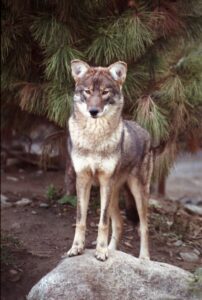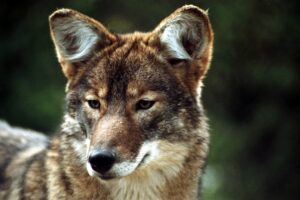Fewer than 50 years ago, there were no coyotes on Cape Cod. Now, they seem to be everywhere.

It seems as if every Outer Cape resident has a story about a coyote encounter. People see them crossing dunes, prancing along dirt roads, prowling oyster flats, chasing deer and rabbits through back yards, and rooting through trash. But these elusive and far-ranging animals are difficult to study, and there’s been a dearth of information about their population here.
Now, a pair of studies by University of Vermont master’s degree students are helping bring more about our Outer Cape coyotes to light. The first, by Koryna Boudinot, studied the scat of the coyotes in the National Seashore to arrive at an estimate that there are approximately 81 individuals here, with DNA testing revealing that among them there is very little inbreeding. This suggests that “our” coyotes may travel far and wide throughout their lives.
The second study, by Carolyn Hanrahan, analyzed the same coyote scat and found that a large portion of these animals’ diet consists of human food including chicken, beef, and pork, along with white-tailed deer meat. This suggests that while coyotes may play a significant role in keeping deer populations in check, they have also become reliant on scavenging from sources like pet food and garbage — both provided by humans.
For most of its history, Cape Cod had no coyotes. Before the 1900s, they were found only in the western U.S. Instead, a small subspecies of wolf roamed this land, according to Jonathan Way, a coyote researcher with a Ph.D. from Boston College who founded a Barnstable-based organization called Eastern Coyote/Coywolf Research and has studied these animals across New England. When European settlers arrived and began slaughtering wolves, they were driven off the Cape, Way said.
After that, for at least 300 years there were no large carnivores on Cape Cod. Then, Way said, as wolves disappeared from the Great Lakes region and forests were converted into farmland, coyotes spread eastward, taking advantage of the changing habitat and lack of competition from other predators. In the 1920s, Way said, they reached the area around Algonquin Provincial Park in central Ontario, Canada, where they started breeding with the area’s wolf population.

The animals that resulted were hybrids, meaning they contain the DNA of more than one species. They are now known as “eastern coyotes” or “coywolves,” Way said.
Way and other researchers have sampled eastern coyote DNA across the animals’ range, and he said that most eastern coyotes’ DNA is about 60 to 65 percent coyote and 20 to 30 percent wolf. But there’s another species in the mix: researchers have found that the coywolf makeup is some 10 to 15 percent domestic dog.
“We don’t know how the dog came into play,” Way said, since domestic and wild canines have different reproductive cycles, “but it seemed to happen.”
This hybrid, Way said, was perfectly suited to spreading throughout eastern North America: it had the coyote’s ability to thrive in open and human-dominated areas, but it was slightly larger and shared wolves’ appetite for deer. Coywolves reached Massachusetts in the 1950s and the Cape in the mid-1980s. Once here, Way said, “it just took them about 10 years to saturate and colonize the entire Cape from one side to the other.”
Now, 40 years after their arrival, Boudinot’s study is the first to try to figure out just how many coyotes actually live on the Outer Cape. To do this, she and her team spent the fall of 2022 and summer of 2023 collecting samples of coyote scat from throughout the Seashore to identify individual animals. Then she used a cutting-edge technique known as pedigree reconstruction to reverse-engineer a family tree of the coyotes and arrive at her estimate of approximately 81 individuals — a density that is “generally higher than found in other regions,” Boudinot said.
The population was extremely genetically diverse, too. That’s how she knows that our “local” coyotes may come and go frequently as they breed.
Hanrahan’s research looks at how the Cape’s flourishing coyote population might be affecting the local environment. Her research was meant to test whether coyotes in the Seashore were eating threatened shorebirds — specifically, piping plovers and least terns — and possibly impeding conservation efforts for those birds.
To do this, Hanrahan looked at the same scat samples that Boudinot had used to determine the DNA of all the prey in that sample. To her surprise, of the 428 samples she tested, none contained DNA of any threatened shorebird.
That’s when she found evidence of the degree to which coyotes here have come to rely on garbage and food waste left by humans. Approximately 50 to 70 percent of samples contained chicken, and pork and beef appeared in 5 to 15 percent of the samples — the numbers varied depending on the season.
This finding is worrisome, she said, because a reliance on scavenged human or pet foods may further exacerbate human and coyote conflict.
Hanrahan said that a 2020 study led by Scott Sugden from the University of Alberta found that coyotes that eat human food sources are less healthy and possibly more prone to aggression.
While coyote attacks are extremely rare on Cape Cod, they have occurred. In the summer of 2021, the Independent reported that a coyote bit a three-year-old girl at Herring Cove, and that same October, a coyote bit a 16-year-old boy at Harding’s Beach in Chatham, according to CBS news.
But Cape Cod’s coyotes are not entirely reliant on human food sources. Hanrahan found that more than half of the samples she studied also contained deer DNA. This means coyotes scavenge, but they also still hunt in packs, she said. In total, Hanrahan found 27 vertebrate species in her scat samples, including small mammals like rabbits, birds like turkeys, and marine mammals like seals and pygmy sperm whales.
When she presented her research, Hanrahan said she was struck by how people reacted to her finding that coyotes do not pose a threat to shorebirds. “This is very controversial for some reason,” she said. She recalled one presentation where an audience member discounted her results and said, “I don’t believe you.”
Hanrahan said she attributes this reaction to people’s preconceived notions of coyotes as dangerous. But some data suggest that those attitudes are changing here: A 2015 study led by social scientist Jennifer Jackman from Salem State University found that, in 2005, many Cape Codders felt that coyotes were a problem and their population needed reduction. By 2012, those attitudes had softened.
Way points out that the area we now call Cape Cod had a large land predator for most of its history. The arrival of coyotes helped refill the niche left empty after European settlers killed off the wolves.



